High-Gain Dual-Polarization Microstrip Antenna Based on Transmission Focusing Metasurface
Abstract
:1. Introduction
2. The Design of the Feed Antenna and Focusing MS
2.1. Dual-Polarization Feed MA
2.2. Transmission-Mode Dual-Polarization Focusing MS
3. Dual-Polarization Transmission-Mode Focusing MS Antenna
4. Conclusions
Author Contributions
Funding
Institutional Review Board Statement
Informed Consent Statement
Data Availability Statement
Conflicts of Interest
References
- Li, W.; Liu, S.; Deng, J.; Hu, Z. A compact SIW monopulse antenna array based on microstrip feed. IEEE Antennas Wireless Propag. Lett. 2020, 20, 93–97. [Google Scholar] [CrossRef]
- Chen, C. An Ultraminiature Circularly Polarized Microstrip Patch Antenna with MIM Capacitors. IEEE Antennas Wireless Propag. Lett. 2023, 22, 496–500. [Google Scholar] [CrossRef]
- Hussain, N.; Jeong, M.J.; Abbas, A.; Kim, T.J.; Kim, N. A metasurface-based low-profile wideband circularly polarized patch Antenna for 5G millimeter-wave systems. IEEE Access 2020, 8, 22127–22135. [Google Scholar] [CrossRef]
- Bancroft, R. Microstrip antenna efficiency and surface wave loss. IEEE Trans. Antennas Propag. 2021, 69, 5032–5035. [Google Scholar] [CrossRef]
- Huang, D.; Xu, G.; Wu, J.; Wang, W.; Yang, L.; Huang, Z.X.; Wu, X.L.; Yin, W.Y. A microstrip dual-split-ring antenna array for 5G millimeter-wave dual-band applications. IEEE Antennas Wireless Propag. Lett. 2022, 21, 2025–2029. [Google Scholar] [CrossRef]
- Pandey, B.K.; Chakrabarty, S.B.; Jyoti, R. Common aperture dual-band dual-polarized planar microstrip antenna. IETE J. Res. 2018, 64, 489–496. [Google Scholar] [CrossRef]
- Roy, C.; Khan, T. Single-feed dual-polarized high gain microstrip antenna. Wireless Pers. Commun. 2019, 108, 1417–1430. [Google Scholar] [CrossRef]
- Ding, X.H.; Yang, W.W.; Tang, H.; Guo, L.; Chen, J.X. A dual-band shared-aperture antenna for microwave and millimeter-wave applications in 5G wireless communication. IEEE Trans. Antennas Propag. 2022, 70, 12299–12304. [Google Scholar] [CrossRef]
- Dasari, R.K.; Pandharipande, V.M.; Koul, S.K. A new microstrip patch antenna with triple-polarization diversity. Microw. Opt. Techn. Let. 2014, 56, 1348–1353. [Google Scholar] [CrossRef]
- Korošec, T.; Ritoša, P.; Vidmar, M. Varactor-tuned microstrip-patch antenna with frequency and polarization agility. Electron. Lett. 2006, 42, 1015–1017. [Google Scholar] [CrossRef]
- Cao, W.Q.; Wang, Q.Q.; Zhang, B.N.; Hong, W. Capacitive probe-fed compact dual-band dual-mode dual-polarisation microstrip antenna with broadened bandwidth. IET Microw. Antenna. Propag. 2017, 11, 1003–1008. [Google Scholar] [CrossRef]
- Hong, Y.P.; Kim, J.M.; Jeong, S.C.; Kim, D.H.; Yook, J.G. Low profile S-band dual-polarized antenna for SDARS application. In European Conference on Wireless Technology, 2005; IEEE: New York, NY, USA, 2005; pp. 451–454. [Google Scholar]
- Zahra, S.; Ma, L.; Wang, W.; Li, J.; Chen, D.; Liu, Y.; Wen, G. Electromagnetic metasurfaces and reconfigurable metasurfaces: A review. Front. Phys. 2021, 8, 593411. [Google Scholar] [CrossRef]
- Deng, M.; Cotrufo, M.; Wang, J.; Dong, J.; Ruan, Z.; Alù, A.; Chen, L. Broadband angular spectrum differentiation using dielectric metasurfaces. Nat. Commun. 2024, 15, 2237. [Google Scholar] [CrossRef]
- Ju, Z.Z.; Wen, J.; Shi, L.N.; Yu, B.B.; Deng, M.; Zhang, D.W.; Hao, W.M.; Wang, J.; Chen, S.Q..; Chen, L. Ultra-Broadband High-Efficiency Airy Optical Beams Generated with All-Silicon Metasurfaces. Adv. Opt. Mater. 2021, 9, 2001284. [Google Scholar] [CrossRef]
- Huang, Z.R.; Zheng, Y.Q.; Li, J.H.; Cheng, Y.Z.; Wang, J.; Zhou, Z.K.; Chen, L. High-Resolution Metalens Imaging Polarimetry. Nano Lett. 2023, 23, 10991–10997. [Google Scholar] [CrossRef] [PubMed]
- Wang, Q.; Cheng, Y.Z. Compact and low-frequency broadband microwave metamaterial absorber based on meander wire structure loaded resistors. AEU-Int. J. Electron. Commun. 2020, 120, 153198. [Google Scholar] [CrossRef]
- Li, Z.R.; Cheng, Y.Z.; Luo, H.; Chen, F.; Li, X. Dual-band tunable terahertz perfect absorber based on all-dielectric InSb resonator structure for sensing application. J. Alloys Compd. 2022, 925, 166617. [Google Scholar] [CrossRef]
- Ding, Z.P.; Su, W.; Luo, Y.; Ye, L.; Li, W.; Zhou, Y.; Tang, B.; Yao, H. Artificial neural network-based inverse design of metasurface absorber with tunable absorption window. Mater. Des. 2023, 234, 112331. [Google Scholar] [CrossRef]
- Cai, B.; Wu, L.; Zhu, X.; Cheng, Z.Z.; Cheng, Y.Z. Ultra-broadband and wide-angle plasmonic light absorber based on all-dielectric gallium arsenide (GaAs) metasurface in visible and near-infrared region. Results Phys. 2024, 58, 107509. [Google Scholar] [CrossRef]
- Wu, L.; Yang, L.L.; Zhu, X.W.; Cai, B.; Cheng, Y.Z. Ultra-broadband and wide-angle plasmonic absorber based on all-dielectric gallium arsenide pyramid nanostructure for full solar radiation spectrum range. Int. J. Therm. Sci. 2024, 201, 109043. [Google Scholar] [CrossRef]
- Gorkunov, M.V.; Kasyanova, I.V.; Artemov, V.V.; Ezhov, A.A.; Mamonova, A.V.; Simdyankin, I.V.; Palto, S.P. Superperiodic liquid-crystal metasurfaces for electrically controlled anomalous refraction. ACS Photonics 2020, 7, 3096–3105. [Google Scholar] [CrossRef]
- He, Y.Q.; Cai, B.; Wu, L.L.; Chen, L.; Cheng, Y.Z.; Chen, F.; Luo, H.; Li, X.C. Tunable VO2 metasurface for reflective terahertz linear and circular polarization wavefront manipulation at two frequencies independently. Phys. B 2024, 681, 415848. [Google Scholar] [CrossRef]
- Yin, X.; Zhu, H.; Guo, H.; Deng, M.; Xu, T.; Gong, Z.; Li, X.; Zhang, Z.H.; Wu, C.; Li, H.; et al. Hyperbolic Metamaterial Devices for Wavefront Manipulation. Laser Photonics Rev. 2019, 13, 1800081. [Google Scholar] [CrossRef]
- Yang, D.R.; Cheng, Y.Z.; Luo, H.; Chen, F.; Wu, L. Ultra-thin and ultra-broadband terahertz single-layer metasurface based on double-arrow-shaped resonator structure for full-space wavefront manipulation. Adv. Theor. Simul. 2023, 6, 2300162. [Google Scholar] [CrossRef]
- Li, J.; Cheng, Y.Z.; Li, X.C. Terahertz transmission-type metasurface for the linear and circular polarization wavefront manipulation. Adv. Theory Simul. 2022, 5, 2200151. [Google Scholar] [CrossRef]
- Wu, T.; Chen, J.; Wang, M.J. Multi-state circularly polarized antenna based on the polarization conversion metasurface with gain enhancement. IEEE Access 2020, 8, 84660. [Google Scholar] [CrossRef]
- Zhao, J.C.; Li, N.; Cheng, Y.Z. Ultrabroadband chiral metasurface for linear polarization conversion and asymmetric transmission based on enhanced interference theory. Chin. Opt. Lett. 2023, 21, 113602. [Google Scholar] [CrossRef]
- Wang, J.; Li, Y.; Jiang, Z.H.; Shi, T.; Tang, M.C.; Zhou, Z.; Chen, Z.N.; Qiu, C.W. Metantenna: When metasurface meets antenna again. IEEE Trans. Antennas Propag. 2020, 68, 1332–1347. [Google Scholar] [CrossRef]
- Boyarsky, M.; Sleasman, T.; Imani, M.F.; Gollub, J.N.; Smith, D.R. Electronically steered metasurface antenna. Sci. Rep. 2021, 11, 4693. [Google Scholar] [CrossRef] [PubMed]
- Faenzi, M.; González-Ovejero, D.; Maci, S. Flat gain broadband metasurface antennas. IEEE Trans. Antennas Propag. 2020, 69, 1942–1951. [Google Scholar] [CrossRef]
- Bodehou, M.; Monnoyer, G.; Drouguet, M.; Khalifeh, K.A.; Vandendorpe, L.; Craeye, C. Metasurface Antennas for FMCW Radar. IEEE Antennas Wireless Propag. Lett. 2022, 22, 1040–1044. [Google Scholar] [CrossRef]
- Benini, A.; Barrera, A.M.; Martini, E.; Toccafondi, A.; Maci, S. Self-complementary hyperbolic metasurface antennas. IEEE Trans. Antennas Propag. 2023, 71, 3816–3827. [Google Scholar] [CrossRef]
- Zhu, B.; Yang, D.; Pan, J.; Chen, Y.; Liu, S. A Low-Profile Metasurface-Inspired Antenna With Tilted Beam Radiation. IEEE Antennas Wireless Propag. Lett. 2023, 22, 1803–1807. [Google Scholar] [CrossRef]
- Tahir, M.U.; Rafique, U.; Ahmed, M.M.; Abbas, S.M.; Iqbal, S.; Wong, S.W. High gain metasurface integrated millimeter-wave planar antenna. Int. J. Microw. Wirel. Trans. 2023, 1–12. [Google Scholar] [CrossRef]
- Lian, J.W.; Ding, D.; Chen, R. Wideband millimeter-wave substrate-integrated waveguide-fed metasurface antenna. IEEE Trans. Antennas Propag. 2022, 70, 5335–5344. [Google Scholar] [CrossRef]
- Feng, M.; Li, Y.; Wang, J.; Zheng, Q.; Sui, S.; Wang, C.; Chen, H.; Ma, H.; Qu, S.; Zhang, J. Ultra-wideband and high-efficiency transparent coding metasurface. Appl. Phys. A 2018, 124, 1–8. [Google Scholar] [CrossRef]
- Chen, K.; Yang, Z.; Feng, Y.; Zhu, B.; Zhao, J.; Jiang, T. Improving microwave antenna gain and bandwidth with phase compensation metasurface. AIP Adv. 2015, 5, 067152. [Google Scholar] [CrossRef]
- Chen, Z.N.; Qing, X. Bandwidth enhancement of a single-feed circularly polarized antenna using a metasurface. IEEE Antenn Propag. Mag. 2016, 50, 39–46. [Google Scholar]
- Epstein, A.; Wong, J.P.; Eleftheriades, G.V. Cavity-excited Huygens’ metasurface antennas for near-unity aperture illumination efficiency from arbitrarily large apertures. Nat. Commun. 2016, 7, 10360. [Google Scholar] [CrossRef]
- Han, Y.; Zhu, L.; Bo, Y.; Che, W.; Li, B. Novel low-RCS circularly polarized antenna arrays via frequency-selective absorber. IEEE Trans. Antennas Propag. 2019, 68, 287–296. [Google Scholar] [CrossRef]
- Liang, J.J.; Huang, G.L.; Zhao, J.N.; Gao, Z.J.; Yuan, T. Wideband phase-gradient metasurface antenna with focused beams. IEEE Access 2019, 7, 20767–20772. [Google Scholar] [CrossRef]
- Hua, L.N.; Cheng, H.Y.; Wang, Y.C.; Yang, H.; Liu, Y.; Yang, Y.; Li, S. Bidirectional radiation high-gain antenna based on phase gradient metasurface. Appl. Phys. B 2021, 127, 1–6. [Google Scholar] [CrossRef]
- Wang, J.X.; Cheng, Y.Z.; Luo, H.; Chen, F.; Wu, L. High-gain bidirectional radiative circularly polarized antenna based on focusing metasurface. AEU-Int. J. Electron. Commun. 2022, 151, 154222. [Google Scholar] [CrossRef]
- Wang, J.X.; Zhao, J.C.; Cheng, Y.Z.; Luo, H.; Chen, F. Dual-band high-gain microstrip antenna with a reflective focusing metasurface for linear and circular polarizations. AEU-Int. J. Electron. Commun. 2022, 157, 154413. [Google Scholar] [CrossRef]
- Zhou, E.Y.; Cheng, Y.Z.; Luo, H.; Chen, F. Wideband and high-gain patch antenna with reflective focusing metasurface. AEU-Int. J. Electron. Commun. 2021, 134, 153709. [Google Scholar] [CrossRef]
- Saini, R.K. A Broadband Dual Circularly Polarized Compact Printed Monopole Antenna. Wireless Pers. Commun. 2022, 126, 2621–2633. [Google Scholar] [CrossRef]
- Xie, P.; Wang, G. Gain enhancement of circularly polarized Fabry-Perot resonator antenna using simple superstrate. AEU-Int. J. Electron. Commun. 2023, 165, 154650. [Google Scholar] [CrossRef]
- Liu, S.F.; Xue, Y.; Li, K.Z. A dual-slot Vivaldi antenna with high gain and circular polarization. Chin. J. Radiol. 2023, 38, 470–475. [Google Scholar]
- Kumar, M.V.; Sharma, D. Design of High Gain Metasurface Antenna Using Hybrid African Vulture’s Optimization and Capuchin Search Algorithm for RF Energy Harvestin. Wireless Pers. Commun. 2023, 13, 67–94. [Google Scholar] [CrossRef]
- Li, A.; Chen, W.; Wei, H.; Lu, G.; Alù, A.; Qiu, C.W.; Chen, L. Riemann-encircling exceptional points for efficient asymmetric polarization-locked devices. Phys. Rev. Lett. 2022, 129, 127401. [Google Scholar] [CrossRef]
- Shu, X.; Zhong, Q.; Hong, K.; You, O.; Wang, J.; Hu, G.; Alù, A.; Zhang, S.; Christodoulides, D.N.; Chen, L. Chiral transmission by an open evolution trajectory in a non-Hermitian system. Light-Sci. Appl. 2024, 13, 65. [Google Scholar] [CrossRef] [PubMed]
- Shu, X.; Li, A.; Hu, G.; Wang, J.; Alù, A.; Chen, L. Fast encirclement of an exceptional point for highly efficient and compact chiral mode converters. Nat. Commun. 2022, 13, 2123. [Google Scholar] [CrossRef]
- Ferreira-Gomes, B.; Oliveira, J.O.N.; Mejía-Salazar, J.R. Chiral dielectric metasurfaces for highly integrated, broadband circularly polarized antenna. Sensors 2021, 21, 2071. [Google Scholar] [CrossRef]
- Li, X.; Wang, Y.; Fan, J.; He, J.; Huang, X. Ultra-thin/wide-band polarization conversion metasurface and its applications in anomalous reflection and RCS reduction. Appl. Sci. 2022, 12, 7696. [Google Scholar] [CrossRef]
- Li, B.; Chen, Y.; Yu, S.; Zhou, X.; Wu, Q.; Wang, J.; Li, Y.; Li, F. Ultra-thin broadband circular polarization conversion metasurface for full-space wavefront manipulation application. IEEE Photonics J. 2023, 15, 4601009. [Google Scholar] [CrossRef]
- El-Hakim, H.; Mohamed, H.A. Synthesis of a Multiband Microstrip Patch Antenna for 5G Wireless Communications. J. Infrared Millim. Terahertz Waves 2023, 44, 752–768. [Google Scholar] [CrossRef]
- Chen, Q.; Li, J.Y.; Yang, G.; Cao, B.; Zhang, Z. A polarization-reconfigurable high-gain microstrip antenna. IEEE Trans. Antennas Propag. 2019, 67, 3461–3466. [Google Scholar] [CrossRef]
- Zhou, E.Y.; Cheng, Y.Z.; Chen, F.; Luo, H.; Li, X. Low-profile high-gain wideband multi-resonance microstrip-fed slot antenna with anisotropic metasurface. Prog. Electromagn. Res. 2022, 175, 91–104. [Google Scholar] [CrossRef]
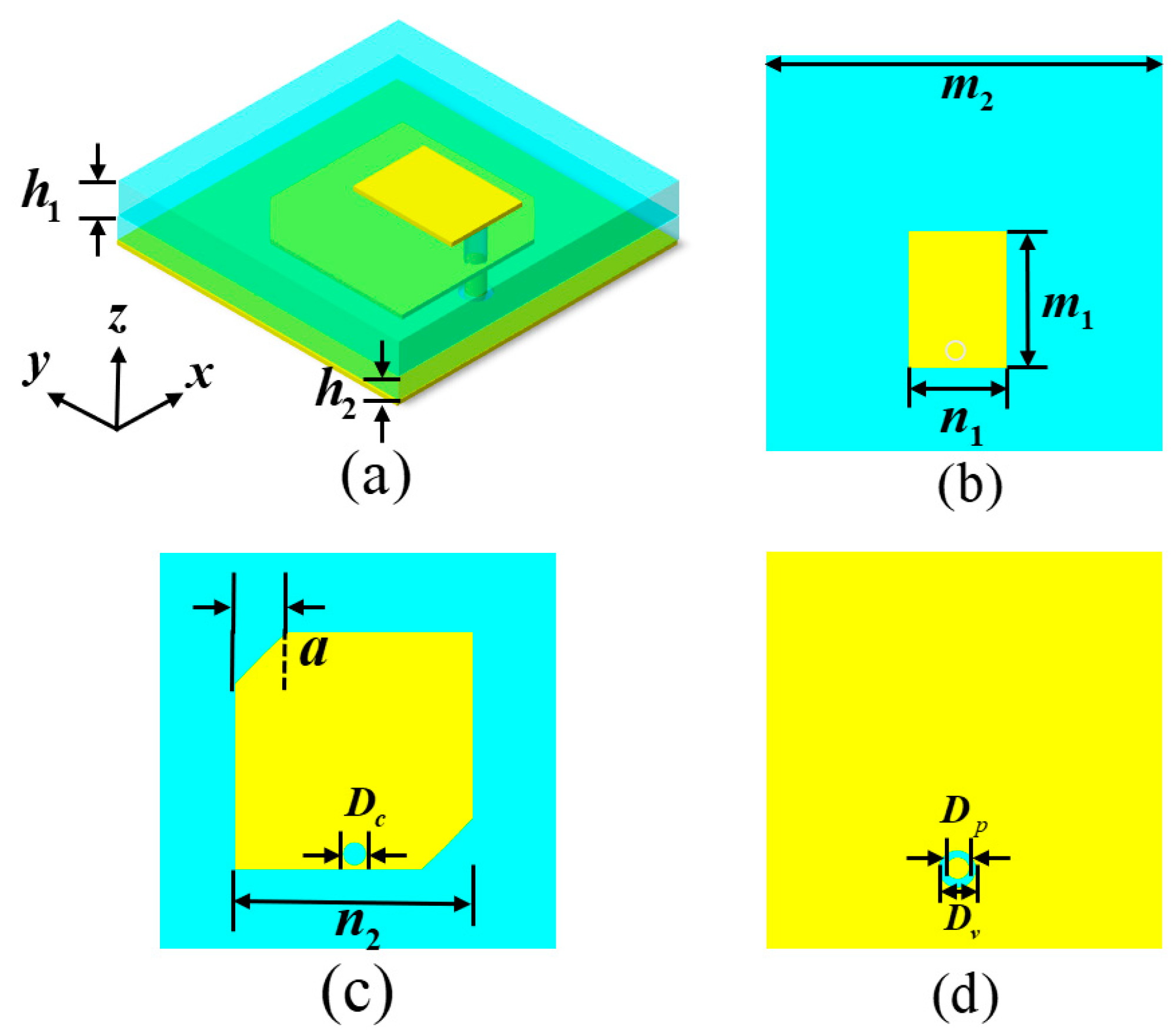


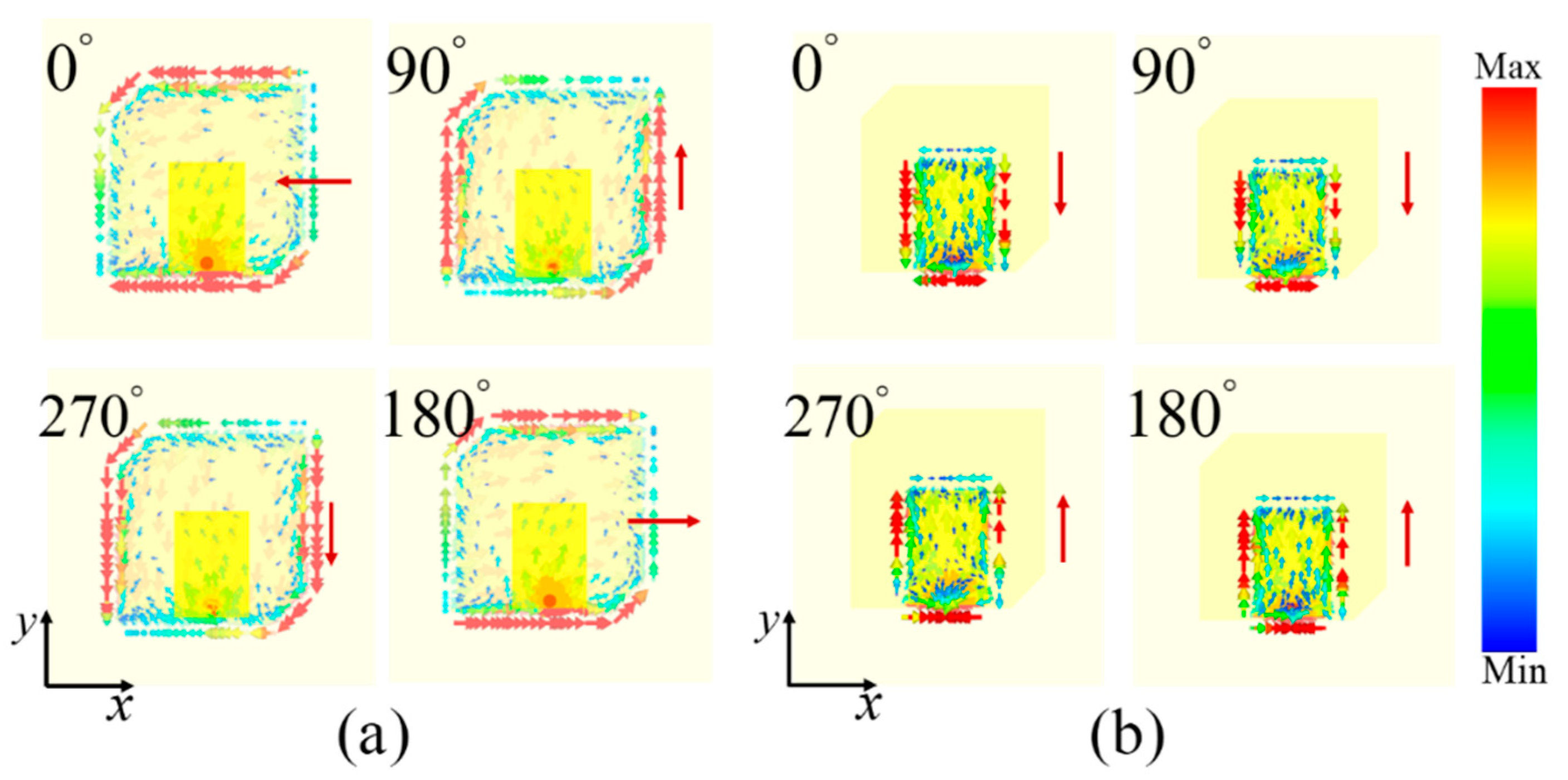


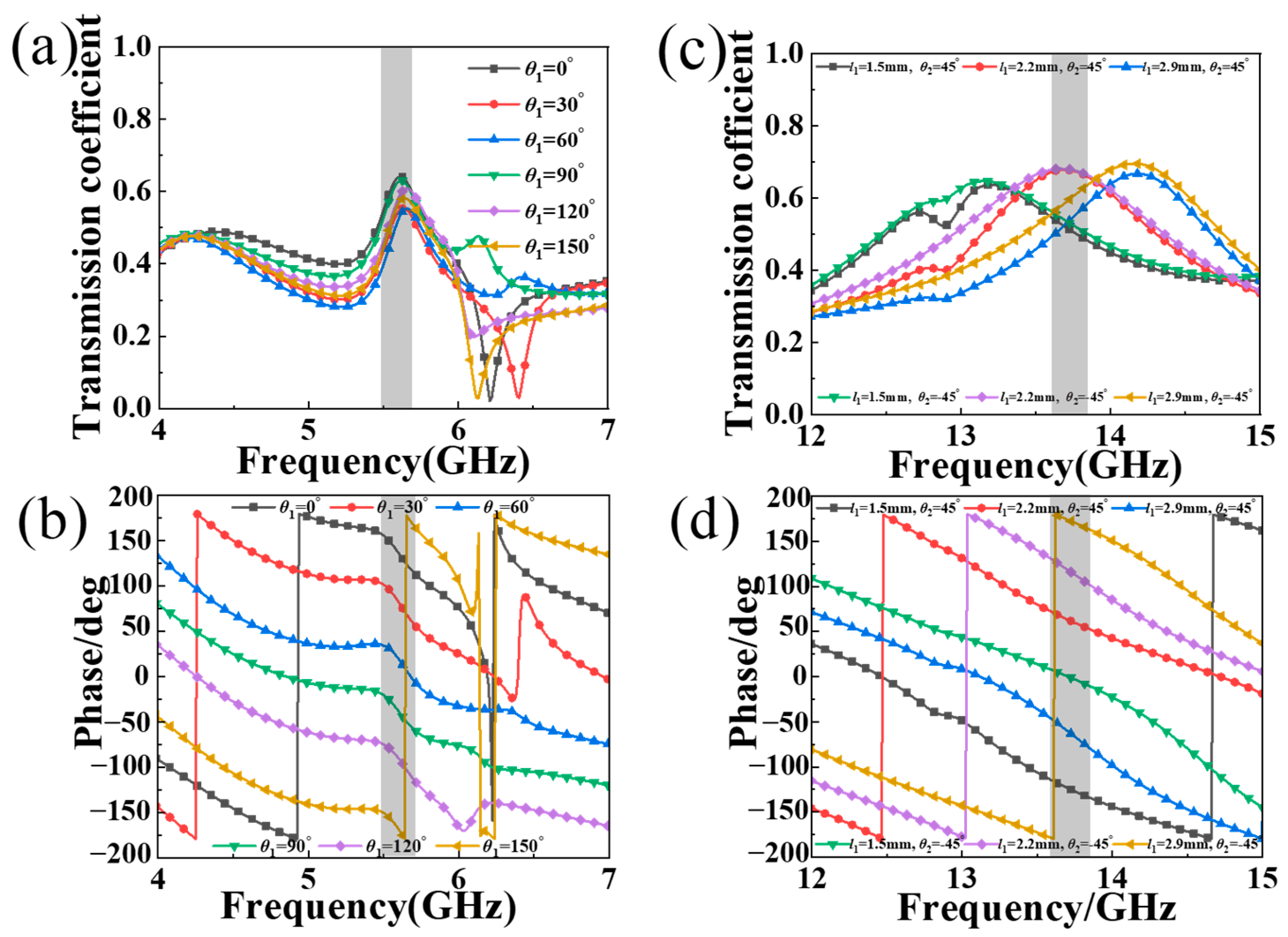
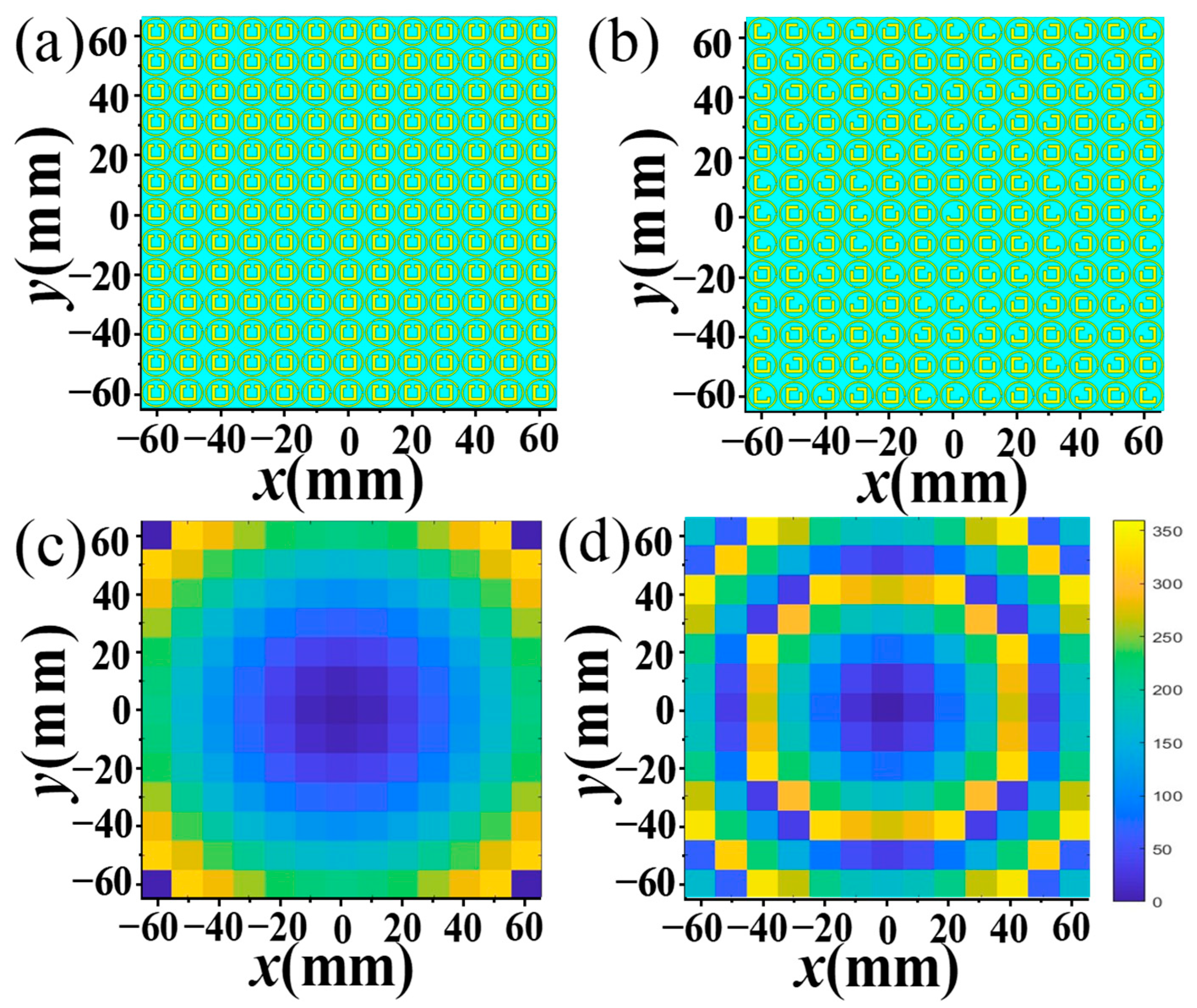
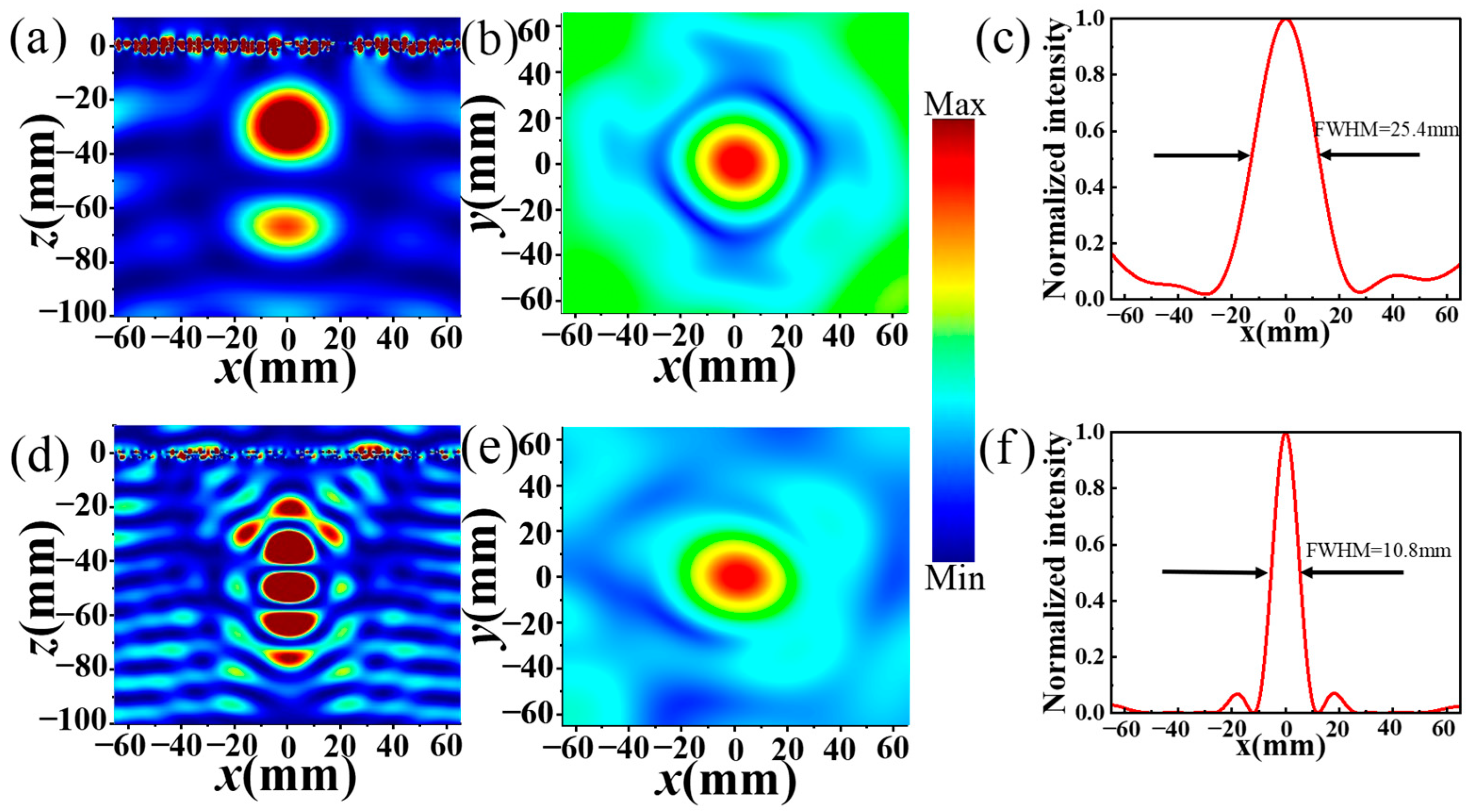
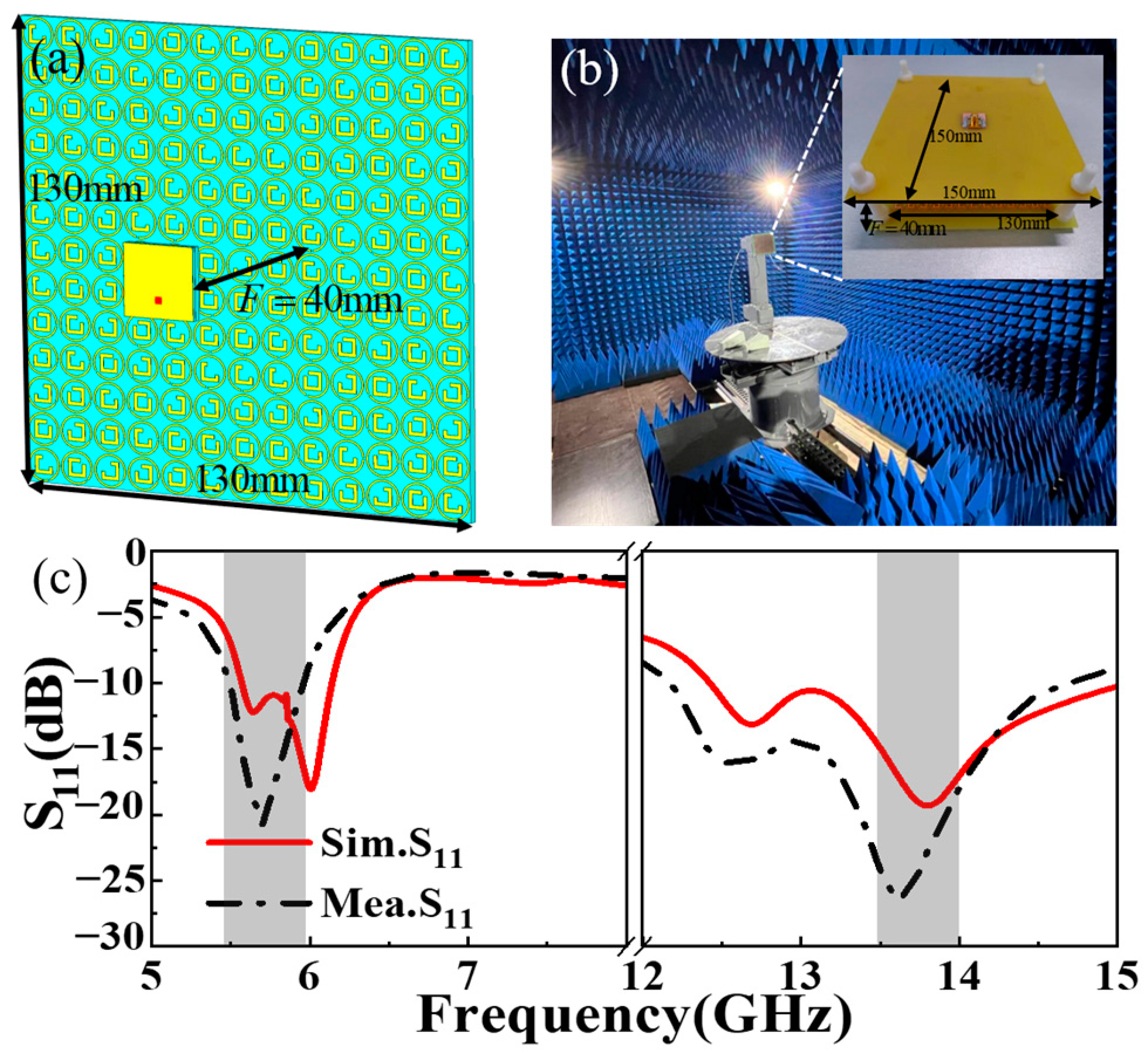
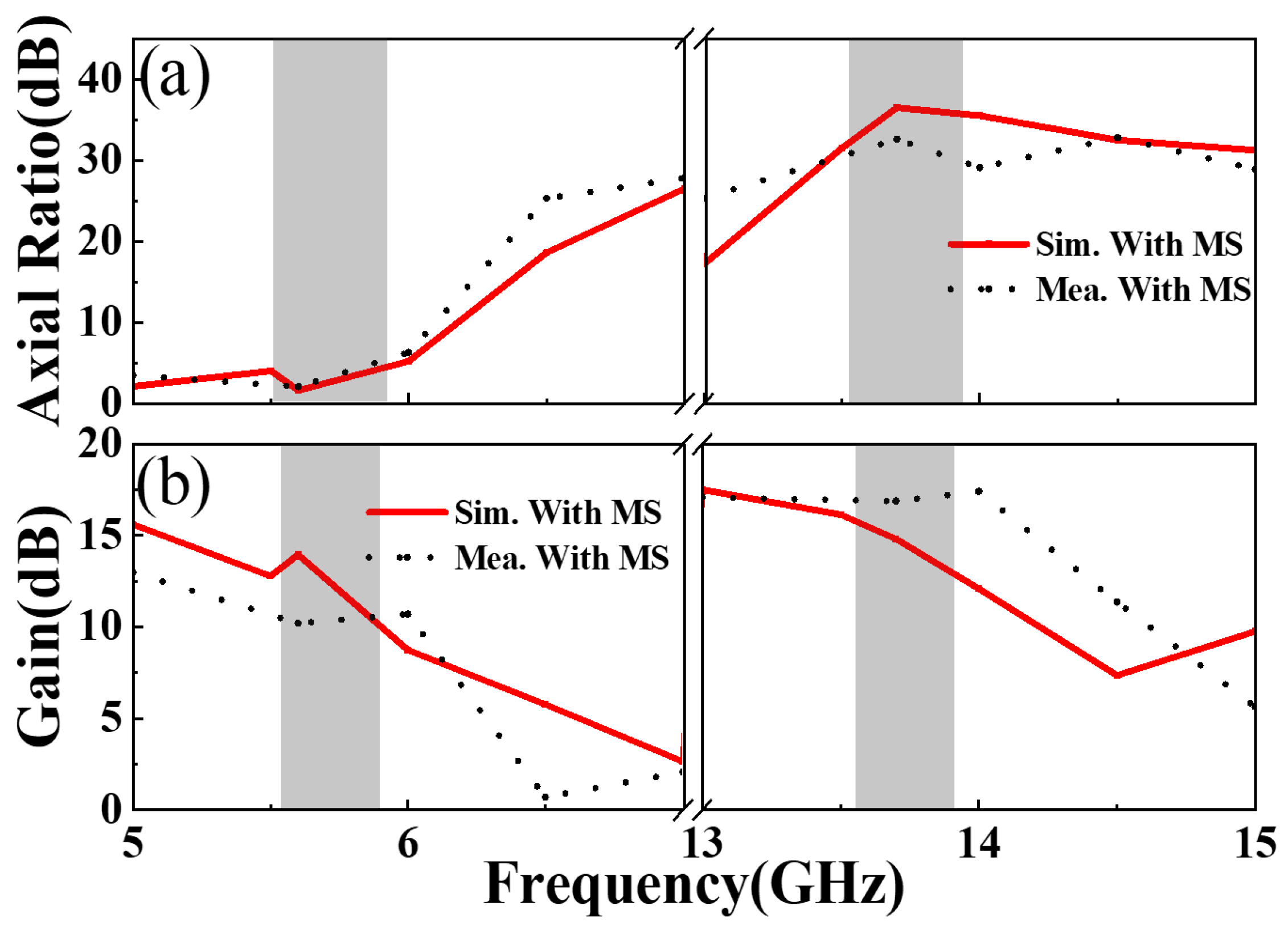
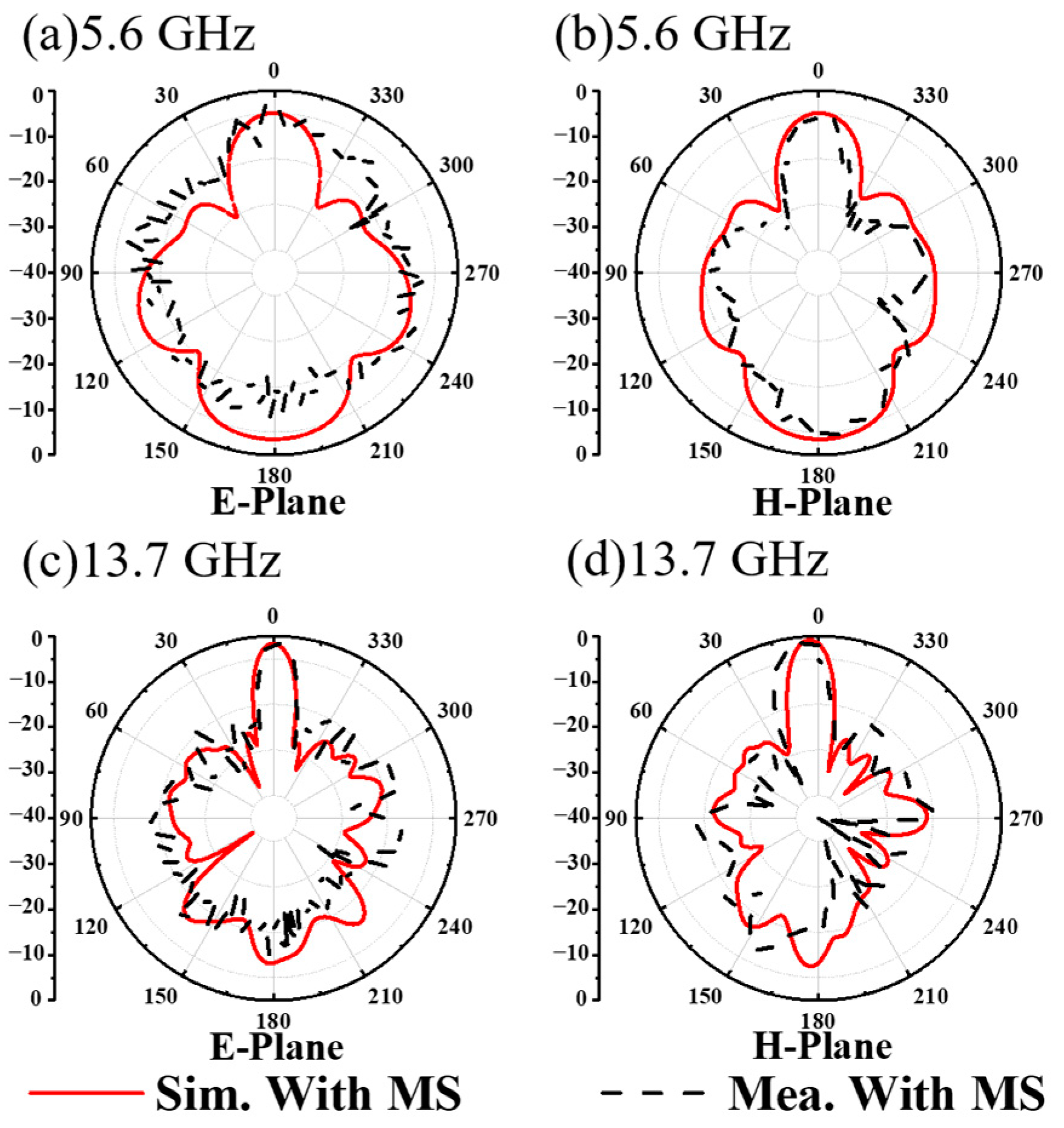
| Ref. | Polarization | Frequency (GHz) | Peak Gain | With Diodes | Gain-Enhanced Method |
|---|---|---|---|---|---|
| [35] | LP | 22.3–40 | 9 dBi (LP) | No | Reflective focusing MS |
| [38] | LP | 5.7 | 9.3 dBi (LP) | No | Huygens MS |
| [42] | CP | 9.4–10.6 | 16.7 dBi (LP) | No | Reflective focusing MS |
| [43] | LP | 15.7/16.5/17.1 | 20.4 dBi (LP) | No | Bidirectional focusing MS |
| [44] | CP | 8.15/14.8 | 19.4 dBic (CP) | No | Full-space focusing MS |
| [50] | CP | 5 | 7.6 dBic (CP) | Yes | Reflective focusing MS |
| This work | CP/LP | 5.6/13.7 | 12.9 dBi (LP)/14.8 dBic (CP) | No | Transmission focusing MS |
Disclaimer/Publisher’s Note: The statements, opinions and data contained in all publications are solely those of the individual author(s) and contributor(s) and not of MDPI and/or the editor(s). MDPI and/or the editor(s) disclaim responsibility for any injury to people or property resulting from any ideas, methods, instructions or products referred to in the content. |
© 2024 by the authors. Licensee MDPI, Basel, Switzerland. This article is an open access article distributed under the terms and conditions of the Creative Commons Attribution (CC BY) license (https://creativecommons.org/licenses/by/4.0/).
Share and Cite
Sun, Y.; Cai, B.; Yang, L.; Wu, L.; Cheng, Y.; Luo, H.; Chen, F.; Li, X. High-Gain Dual-Polarization Microstrip Antenna Based on Transmission Focusing Metasurface. Materials 2024, 17, 3730. https://doi.org/10.3390/ma17153730
Sun Y, Cai B, Yang L, Wu L, Cheng Y, Luo H, Chen F, Li X. High-Gain Dual-Polarization Microstrip Antenna Based on Transmission Focusing Metasurface. Materials. 2024; 17(15):3730. https://doi.org/10.3390/ma17153730
Chicago/Turabian StyleSun, Yibo, Bin Cai, Lingling Yang, Ling Wu, Yongzhi Cheng, Hui Luo, Fu Chen, and Xiangcheng Li. 2024. "High-Gain Dual-Polarization Microstrip Antenna Based on Transmission Focusing Metasurface" Materials 17, no. 15: 3730. https://doi.org/10.3390/ma17153730





